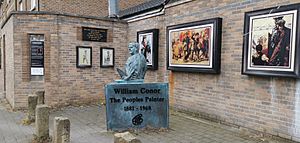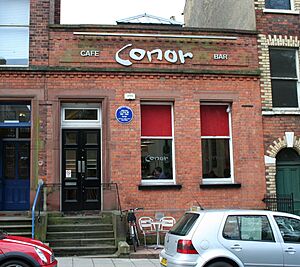William Conor facts for kids
William Conor (1881–1968) was a famous artist from Belfast, Northern Ireland. He was known for his kind and realistic paintings of everyday life for working people in Ulster.
Contents
Early Life and Art School
William Conor was born in 1881 in Belfast. His father worked with metal. From a young age, William showed a special talent for art. When he was just ten years old, a music teacher named Louis Mantell noticed his amazing chalk drawings. This teacher helped William get into the College of Art in Belfast.
After finishing his studies, William became an apprentice at a company called David Allen and Sons. They made posters and other printed materials. Even though he learned many skills there, William really wanted to be a full-time artist.
Becoming a Professional Artist
Around 1910 or 1911, William Conor left his job to follow his dream of becoming an artist. He spent some time living on Great Blasket Island in County Kerry, Ireland. He also took trips to places like Ardara and Kinlough in County Donegal to sketch.
Later, around 1912 or 1913, Conor traveled to Paris, France. There, he studied the works of famous old painters from the Netherlands and Italy. He learned how to create detailed and realistic paintings. However, it was hard for him to make enough money in Paris, so he returned home after about six months.
In 1913, he was chosen to be part of the committee for the Belfast Art Society Council.
Art During Wartime
When World War I started in 1914, William Conor was asked by the British government to help. He was commissioned to draw and paint official pictures of soldiers and people working in factories making weapons. These artworks helped record what life was like during the war.
Moving to London and Exhibitions
In 1920, Conor moved to London, England. There, he met and spent time with other well-known artists like Sir John Lavery and Augustus John. His art was shown in important exhibitions.
He displayed his work at the Royal Academy (RA) in London in 1921. He also showed nearly 200 of his paintings at the RHA in Dublin between 1918 and 1967.
Recognition and Awards
In 1930, the Belfast Art Society became the Ulster Academy of Arts. William Conor was one of the first artists to be made an Academician there. He became an Associate of the RHA in 1938 and a full member in 1946.
His art was featured in special exhibitions at the Victor Waddington Galleries in 1944 and 1948. In 1952, he received a special award called the OBE (Officer of the Order of the British Empire) for his contributions to art. In 1957, he was elected President of the Royal Ulster Academy (RUA), a position he held until 1964.
Today, more than 50 of his artworks, made with crayon and watercolor, are kept in the permanent collections of the Ulster Museum.




